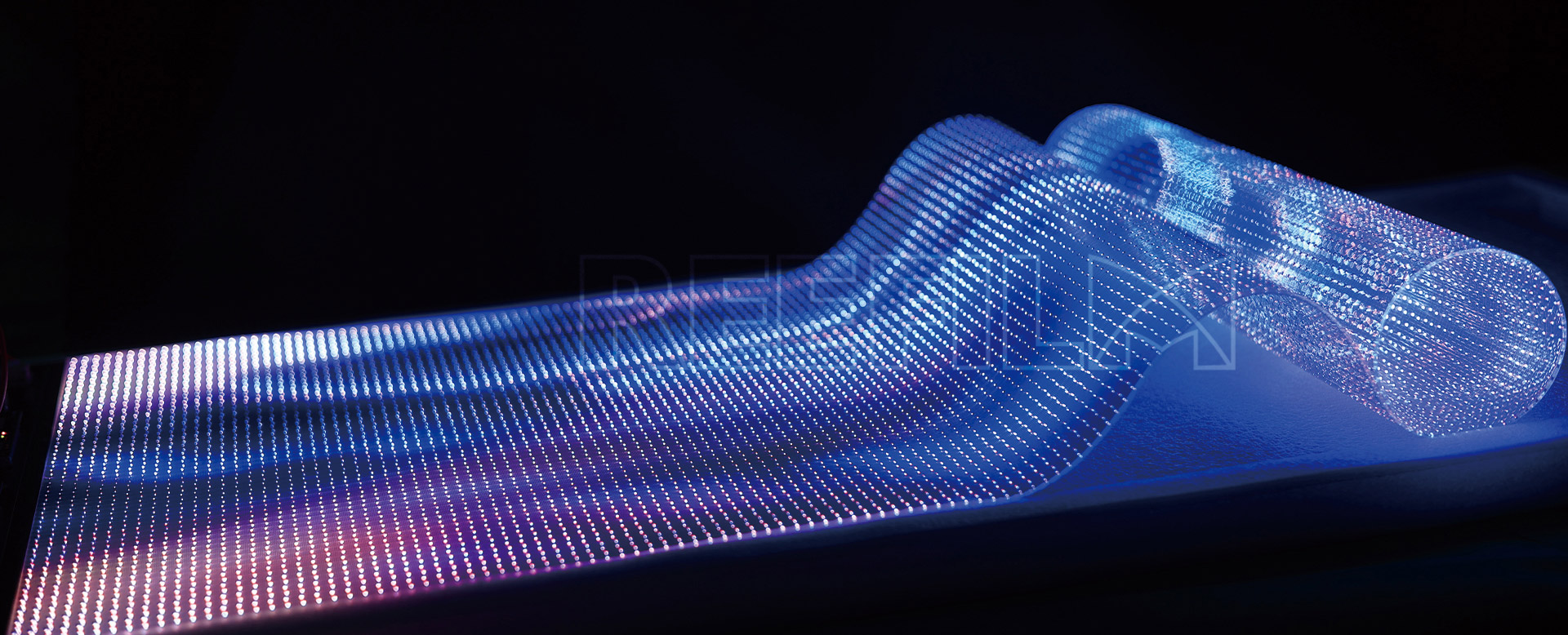
With the continuous iteration of digital display technology, traditional LED display screens can no longer meet the diverse needs of thinness, flexibility, and High transmittance. As a representative of the new generation of display technology, LED Film (LED Flexible Display film) has become a new favorite in the fields of smart buildings, commercial displays, automotive glass, stage and stage art with its ultra-thin, flexible, and adherable to glass and other medium surfaces.
This article will systematically analyze Led Film Display technology from the aspects of definition, technical principles, product structure, performance advantages, typical applications, selection key points, and future trends, to help you quickly understand and evaluate its application potential in actual projects.
1. What is LED Film?
LED Film (also known as LED flexible display film or LED transparent film) is an ultra-thin, flexible display solution based on Mini/Micro LED or COB packaging technology. It integrates LED light-emitting chips on flexible transparent substrates (such as PET or TPU), and realizes the display of images, text, and video content through precise circuit design. At the same time, it has the characteristics of high transmittance, bendability, thinness and fit.
Compared with traditional LED display screens, LED Film does not rely on heavy box structures, does not require special steel structure installation, and can be directly attached to transparent/flat substrates such as glass, acrylic, and walls, becoming the core carrier of "architecture is display".
2. Core technology and working principle of LED Film
1. Basic structural composition:
LED Film is mainly composed of the following parts:
Component Functional description
Light-emitting unit (LED chip) Usually Mini LED or Micro LED, which determines the display brightness and life
Flexible circuit board (FPC) Realizes electrical connection between chips and supports image driving
Transparent substrate (PET/TPU) Provides support structure while maintaining high light transmittance and flexibility
Drive circuit + control IC Receive video signals and control the on and off of each pixel
Adhesive layer/glue layer Realizes bonding with glass or other media
2. Display principle:
LED Film receives video signals from the control system and controls the LED pixel to emit light through the driver IC. Each pixel (or pixel group) can independently control brightness and color to achieve dynamic image output. Its layout is generally arranged in rows and columns, and the pixel pitch ranges from P3.9 to P10, which directly affects the display resolution.
III. Key technical advantages of LED Film
1. Ultra-thin and transparent
The thickness of LED Film is usually less than 1-3mm, and the transmittance is as high as 85% or more. After bonding, it hardly affects the transparency of the glass, achieving the "invisible display" effect.
2. Flexible and attachable
The flexible circuit and substrate design can be easily attached to structures such as flat surfaces, curved glass, and curved curtain walls, breaking through structural limitations.
3. No structural load
No traditional steel structure or box support is required, which greatly reduces the weight of the system (<2kg/m²), suitable for the renovation of old buildings and high-rise glass curtain walls.
4. Strong customizability
Supports customization of any size, shape, and pixel pitch to meet various building sizes and creative modeling requirements.
5. Energy saving and long life
Mini/Micro LED has the advantages of low power consumption, high brightness, and high stability. The lifespan is usually >50,000 hours and the maintenance cost is low.
6. Safety and convenient construction
The film design facilitates quick construction, and maintenance can be carried out from the indoor side to avoid the risk of high-altitude operations. It also meets industrial safety standards such as flame retardant and waterproof.
IV. Typical application areas
LED Film is widely used in multiple scenarios, providing high-value-added display solutions for customers in various industries:
1. Architectural glass curtain wall
The glass facades of squares, high-rise buildings, and city landmarks can be used to create "architectural media" displays through LED Film, achieving transparent daytime and wonderful nighttime visual effects.
2. Commercial display windows
Transparent display scenes such as retail stores, car 4S stores, and boutique windows are used to play advertisements and dynamic product information to attract customer attention.
3. Intelligent transportation and vehicle glass
The front windshield and windows of future smart cars can be integrated with LED Film to achieve "augmented reality" displays such as navigation information and prompt signs.
4. Stage and exhibition
Combined with lighting and interactive technology, LED Film can be used to create immersive, technological stage backgrounds and exhibition spaces.
5. Museum/exhibition hall information guide
Superimpose dynamic content on glass windows or display stands to enhance the display and explanation effects.